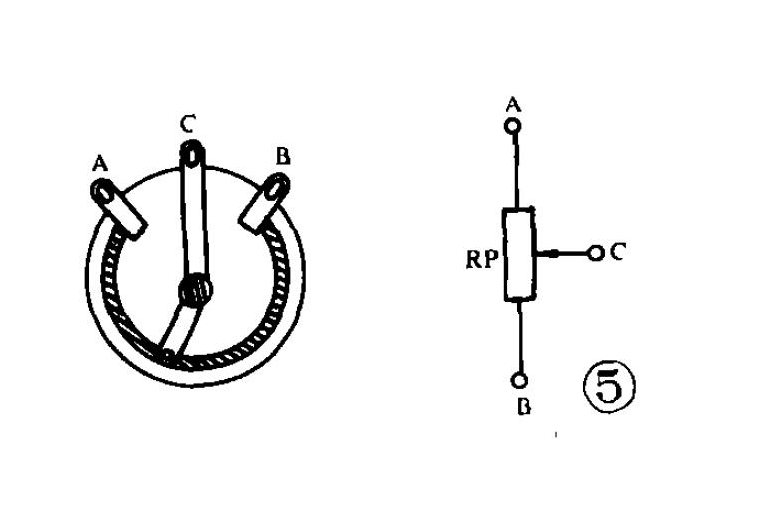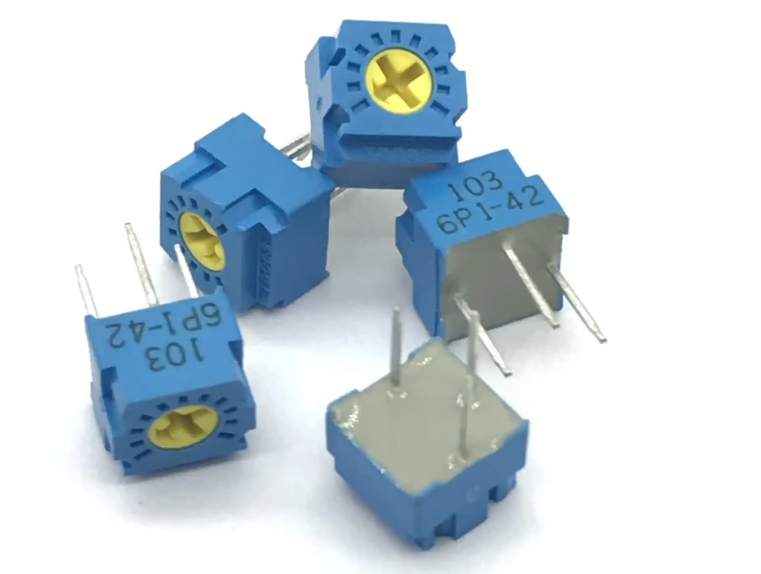Table of Contents
What is a Variable Resistor
A variable resistor is an electronic component whose resistance value can be adjusted manually or automatically to control the current or voltage in a circuit. It is widely used in electronic circuits to adjust parameters such as volume, brightness, and temperature.
Basic Structure
Variable resistors usually consist of the following parts:
Resistor body: made of resistive material (e.g., metal wire, carbon film, etc.), which is the core of the resistance value change.
Moving piece (sliding contact): can be moved on the resistor body to change the effective length of the resistor body.
Fixed Tabs (Fixed Contacts): Usually there are two of them, located at each end of the resistor body.
Working Principle
Resistance Adjustment: When the movable piece moves, the effective length of the resistor body changes, thus changing the resistance value between the fixed piece and the movable piece. For example:
Counterclockwise rotation: the moving piece moves upward, the resistance value between the fixed piece 1 and the moving piece decreases, and the resistance value between the fixed piece 2 and the moving piece increases.
Clockwise rotation: the movable piece moves downward, the resistance value between the fixed piece 1 and the movable piece increases, and the resistance value between the fixed piece 2 and the movable piece decreases.
Extreme position:
When the movable piece moves to the leftmost end (topmost end), the resistance value between the fixed piece 1 and the movable piece is zero, and the resistance value between the fixed piece 2 and the movable piece reaches the maximum value (nominal resistance value).
When the movable piece moves to the rightmost end (the lowest end), the resistance value between the fixed piece 2 and the movable piece is zero, and the resistance value between the fixed piece 1 and the movable piece reaches the maximum value.

Variable Resistor Symbols
The symbols of variable resistors are usually indicated by the letters RP or R in the circuit diagrams, depending on the standards and design conventions.
Symbol
RP: This is the latest national standard symbol for variable resistors, which stands for “Resistor Potentiometer” to emphasize its adjustable resistance value. R: In some old standards or simplified standards, it is used to emphasize its adjustable resistance value.
R: In some older standards or simplified designs, variable resistors may also be directly represented by the letter R, the same as ordinary resistors, but with context or additional symbols (e.g., arrows) to distinguish their variable characteristics.
Graphical Symbols
The graphical symbols for variable resistors add an arrow to the ordinary resistor symbols to indicate that their resistance value can be continuously varied.
For example, in the national standard symbol, the arrow points to one end of the resistor body, indicating the direction of resistance adjustment.
In the old symbol, the arrow may be directly connected to a fixed end, indicating the position of the sliding contact.
Pin Function
Variable resistors usually have three pins: two fixed ends (fixed-tab pins) and one moveable end (moving-tab pin).
The moving-tab pins adjust the resistance value by sliding or rotating to change the contact position with the fixed-tab pins.
Main Types
Variable resistors can be categorized into the following types based on their construction and use:
Potentiometer
A potentiometer is an adjustable resistance element that usually consists of a resistor body and a movable brush. By changing the position of the brush on the resistor body, the potentiometer can adjust the resistance value in a circuit, thereby changing the magnitude of voltage and current. Potentiometers are widely used in electronic circuits to regulate current, voltage, and signal distribution, and are commonly found in audio equipment, home appliances, industrial control systems, and precision instruments.
Photoresistor
A photoresistor (photoresistor or light-dependent resistor) is a semiconductor element based on the internal photoelectric effect, and its resistance value depends on the change in incident light intensity. Photoresistors utilize semiconductor materials to generate electrons under light, thereby changing their resistance value, which varies with the intensity of light and is commonly used in light-controlled circuits.
Thermistors
Thermistors are temperature-sensitive resistors whose resistance value changes significantly with temperature. Depending on the temperature coefficient, thermistors can be categorized into Positive Temperature Coefficient Thermistors (PTC) and Negative Temperature Coefficient Thermistors (NTC). The resistance value of a PTC thermistor increases with temperature, while the resistance value of an NTC thermistor decreases with temperature. The resistance value changes with temperature and is used for temperature detection and control.

Differences with Fixed Resistors
Resistance Value: The resistance value of fixed resistors is not adjustable, while the resistance value of variable resistors can be varied as needed.
Accuracy: Fixed resistors are usually more accurate, while variable resistors are less accurate.
Application: Fixed resistors are used where constant resistance is required, while variable resistors are used where dynamic adjustment is required.
Advantages and Disadvantages
Advantages: high flexibility for a wide range of adjustment needs.
Disadvantages: lower precision and higher failure rate.
Application Scenarios
Variable Resistors have a wide range of applications in the following areas:
Audio devices: e.g. volume control.
Lighting equipment: e.g. dimmer switch.
Motor control: e.g. fan speed regulation.
Sensors: e.g. photoresistors and thermistors for environmental monitoring.
Connection: In actual circuits, the movable piece is usually directly connected to a certain fixed piece to realize the continuous adjustment of the resistance value.
Uses: Variable resistors can be used to adjust current and voltage, or used as voltage dividers and varistors, and are widely used in audio equipment, lighting control, motor speed regulation, and other fields.
CAUTION
RATINGS: Care should be taken not to exceed the rated current and rated voltage of the variable resistor when using it to avoid burning the sliding contacts.
Power Distribution: The rated power is usually assumed to be evenly distributed over the entire resistor body, if the local power is too high, it may lead to component damage.
Through the above principles, variable resistors can flexibly adjust circuit parameters to meet different application requirements.
